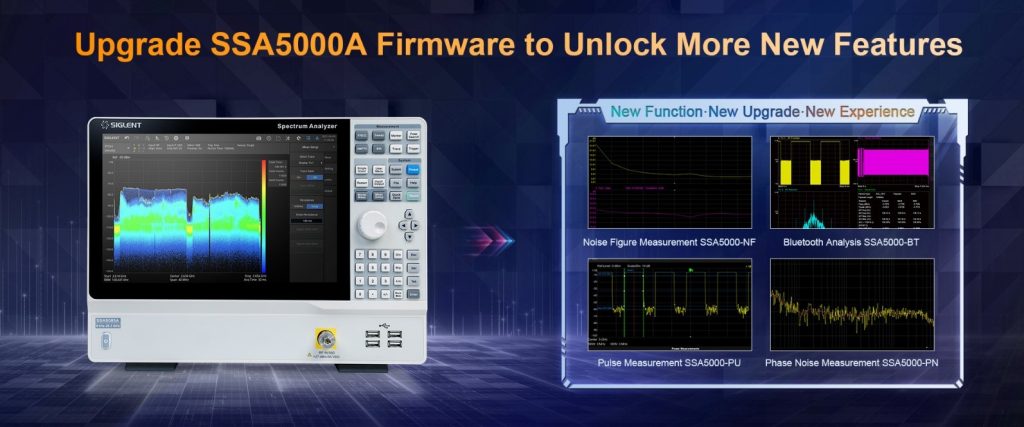Expand into new RF Signal Analysis Applications with the latest SSA5000A Options & Upgrades
January 30, 2024
SIGLENT upgrades SSA5000A with powerful analysis features to cover a wide range of needs.

SIGLENT’s flagship spectrum analyzer now includes additional optional capabilities that extend the instrument function into key signal analysis applications with new tools for phase noise, noise figure, and pulse measurements as well as Bluetooth signal analysis. Extend longevity to keep your test assets current by upgrading firmware and adding new application software and technology.
Bluetooth Analysis (SSA5000-BT)
Bluetooth is widely used in various devices and application scenarios as a wireless communication technology. The measurement application follows the Bluetooth® RF test specification issued by Bluetooth SIG to calculate the measurement results, and automatically detects the protocol version of the signal for Bluetooth BR/EDR/LE with one-click measurements to help you design, evaluate and manufacture Bluetooth devices with confidence. Together with the new SigIQPro signal generation software and a SSG5000X-V generator, it forms an economical and efficient SIGLENT Bluetooth signal generation and signal analysis solution, accelerating the process from signal generation to data to evaluation. The SSA5000A is helpful for users to troubleshoot flexibly in the laboratory and optimize RF design easily and quickly.

Noise Figure Measurement (SSA5000-NF)
Accurate measurement of noise figure is crucial in product development and manufacturing. In the field of research and development, high test accuracy can ensure high repeatability between design simulation and real measurement and help to find the noise sources that are not considered in the simulation process. In the field of production and manufacturing, higher test accuracy means that the index margin can be set smaller when setting and verifying the technical index of the device. The higher the technical index of the final product, the more competitive it will be in the market. Quantifying those unknowns depends on flexible tools that provide accurate, reliable results. The noise figure measurement function of SIGLENT SSA5000A provides engineers with a simple tool, which can quickly and effectively measure the noise figure with high accuracy. Engineers can characterize noise figure and gain of connectorized devices and system blocks with graph, meter, and table layouts, and support the measurement of noise factor, Y-factor, effective temperature, and hot/cold power density.

Phase Noise Measurement (SSA5000-PN)
A stable frequency source is a common need for many electronic devices and most RF equipment. Phase noise can be used to characterize the short-term frequency stability of these frequency sources. Siglent’s SSA5000A Spectrum analyzers now provide a one-button phase noise measurement. The SSA5000A features lower Display Average Noise Level (DANL) and phase noise ensuring the accuracy of your tests. The smaller resolution bandwidth avoids measuring both carrier power and noise power together, and the measurement results are automatically calculated and graphed. The use of a logarithmic scale for the horizontal coordinate gives both a wider frequency range and finer resolution when close to the carrier – smaller offsets tend to reflect the quality of the signal better than phase noise at larger frequency offsets.

Pulse Measurement (SSA5000-PU)
RF pulse signals are widely used in pulse modulation, and for engineers working in related fields, it is challenging to accurately verify RF pulse signals. In some pulse applications, signal design and verification require integrated time domain/frequency domain/modulation test tools for pulse signal analysis. Siglent’s SSA5000A Pulse Measurement option can help engineers better analyze today’s dynamic signal environments with automatic power level, pulse characteristic, and conversion characteristic measurements. With high resolution bandwidth up to 10MHz the rise time measurement result can be as low as 66ns, making accurate measurements on a wide range of pulse types with a variety of triggering methods to cleanly capture the pulse shape.

